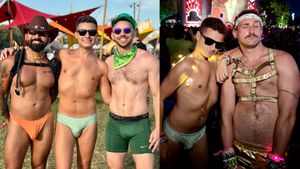CONTACTAbout UsCAREER OPPORTUNITIESADVERTISE WITH USPRIVACY POLICYPRIVACY PREFERENCESTERMS OF USELEGAL NOTICE
© 2025 Pride Publishing Inc.
All Rights reserved
All Rights reserved
By continuing to use our site, you agree to our Privacy Policy and Terms of Use.
On a rainy Tuesday morning, Bill Morgan, a neat, bespectacled, gray-haired author in town from Vermont, is holding a photograph of a young, strikingly handsome Jack Kerouac. Allen took this picture, he says, back in 1953. The Allen is Allen Ginsberg, the legendary Beat poet for whom Morgan worked for 20 years as an archivist and who is at the center of Morgans new book, The Typewriter Is Holy: The Complete, Uncensored History of the Beat Generation. The 27-year-old Ginsberg was walking between his apartment on 7th and B and the closest subway stationfour avenues awaywhen he took the now iconic photo series of Kerouac. It was the fall of 1953, recalls Morgan, four years before On the Road was published and before Kerouac succumbed fully to the alcoholism that would kill him at 47. Kerouac had posed for shots across from the statue of congressman Samuel Cox in Tompkins Square Park and in front of bars on two nearby corners. Now, theres an RIP portrait of the Clashs Joe Strummer and the usual cast of Alphabet City survivors at the spot. Morgans knack for this kind of recall helped persuade Ginsberg to hire him as his archivist and bibliographer 33 years ago, a position Morgan held until Ginsberg died in 1997. Its a job that still consumes him. In Morgans thoughtful, clear-eyed biography of the Beats, no empty bottle or one-night stand that contributed to the mythology of the infamous group of writers is left unexamined. Morgan is in New York City for a book signing and to give me a tour of the Beats East Village. Weve just finished coffee at an upscale 24-hour dinernot one of Allens haunts, Morgan says, explaining that Ginsberg preferred Eastern European food at the nearby Neptune restaurant, which in his day was called KKs Polish restaurant but where a bowl of borscht is still $2.15. We pop open our umbrellas and head across Avenue A. The Beats got together as a group at Columbia first, in the 1940s. More recently, everything was down here, Morgan says. A block and a half east, we end up in front of Ginsbergs first Village apartment, 206 East 7th Street, where he first slept with William Burroughs. Having fled Mexico after shooting his wife, Burroughs was initially rejected by GinsbergI dont want your ugly old cock, he saidbefore he coaxed the younger poet to put out. A few blocks further and were at 170 East 2nd Street, the apartment house where Ginsberg took LSD with Timothy Leary and near where Kerouac would play football in the road using a loaf of rye bread from the Jewish bakery across the street, which is now gone. A high-end home-furnishings boutique sits now occupies the storefront next door. Morgan recalls his own decades spent in the neighborhood, which came to an end when he moved to Vermont a few years back. The real difference is the trees, he says, remembering the barren landscape of pregentrification Alphabet City. He points out a shiny Duane Reade drugstore and recalls the 1970s, when the same corner was a vacant lot used for poetry readings. Its easy enough to pick out from the sidewalk the apartment on East 12th Street, in a building that has housed rocker Richard Hell and poet Simon Pettet, where Peter Orlovsky, the poet who wrote Clean Asshole Poems & Smiling Vegetable Songs, lived with Ginsberg from 1975 through 1996. Its the one on the right, second floor from the top, with the windows reinforced by old-time grates meant to keep out burglars. Not that invited guests had an easier time getting in; the buildings doorbell was always broken, recalls Morgan, so Ginsberg or Orlovsky would toss visitors a sock stuffed with keys from a window. Its still not working today. The pair left in 1996, moving a block away to a building with an elevator on 13th Street where the ailing Ginsberg could give up his trick of telling a story at each of the stairwells landings so he could catch his breath. And thats the apartment where we end our adventure, talking about the upcoming Ginsberg biopic, Howl, and looking at a soon-to-be-released Ginsberg doll designed by the musician and cartoonist Archer Prewitt. The loft now houses the Allen Ginsberg Trust, which oversees the poets estate, and isnt far from what used to be Paradise Alley, the East 11th Street apartment building where Alene Lee, the inspiration for Mardou in Kerouacs The Subterraneans, lived. In the days of Mardou, everyone had a place nearby or was sleeping with somebody who did. But by the time Ginsberg and Orlovsky moved to the loft on 13th Street, most of the other Beats were dead or in seclusion. Not that Ginsberg was ever alone. When Allen was down here, he wasnt a young kid anymore, says Morgan. He had become the central figure of the Beats. People from around the world would come to sit at his feet. The Typewriter is Holy (Free Press) is available now.
Watch Now: Pride Today
Latest Stories
Remembering Jewel Thais-Williams: activist and owner of iconic L.A. nightclub
July 08 2025 7:43 PM
Yes, good and ethical queer porn exists — here’s how to know it when you see it
July 08 2025 12:34 PM
'Drag Race': Snatch Game winners and the celebs they impersonated
July 07 2025 6:21 PM
Who was Lizzie Borden? Meet the 'Monster' season 4 subject
July 08 2025 7:11 PM
GALECA announces 2025 Dorian TV Award winners—here's the full list
July 08 2025 3:42 PM
San Francisco queen Hilary Rivers detained by ICE after asylum hearing
July 08 2025 2:22 PM
Billie Jean King: Listen to transgender athletes
July 08 2025 11:56 AM
California defies Trump, won't ban trans athletes from school sports
July 07 2025 8:18 PM






































































